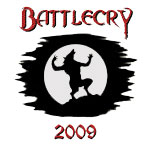For our afternoon challenge we were assigned Ivan Truong and Richard “Uncle Dickie” Foster, and their dastardly Medieval Portuguese. Personally I have bad memories of the latter army from back home in Christchurch in the early nineties (playing DBM 1.1 & 2.0), and my 15mm Minoans & Early Mycenaeans getting regular drubbings by it from Corbon Loughnan! Anyway Campbell and I were a bit concerned by this army, I was actually of the opinion of being prepared to risk our Kn(X) Cataphracts against the Irr Kn(O) but Campbell wasn’t so keen as we would be fighting at a disadvantage due to being graded ‘I’ (inferior) against them.
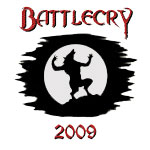 In the end we took a cautious approach and decided to try and pin them in place with our Chionites and hold back our Heavy Kn(X) and Elephants for when we could be confident of a decisive strike where we’d have an advantage – after all this could end up being an ideal opportunity to use a “Feigned Flight” stratagem too…
In the end we took a cautious approach and decided to try and pin them in place with our Chionites and hold back our Heavy Kn(X) and Elephants for when we could be confident of a decisive strike where we’d have an advantage – after all this could end up being an ideal opportunity to use a “Feigned Flight” stratagem too…
The terrain was relatively straight forward – we got basically nothing on our side of the table, the Portuguese managed to place both their gentle hills in useful positions for themselves, as well as a couple of roads, while we positioned two pieces of marsh, one in each of their rear table corners.
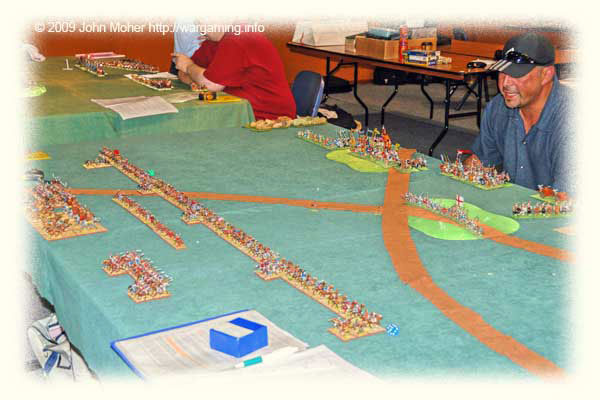
The initial deployment saw me on the left again, the C-in-C with Elephants in the centre, and Campbell on the right (see above). We haggled over using our Scouting Stratagem (I favoured risking 2 Chionite Lh(S) every game regardless if there was even 1 piece of terrain suitable for ambushing – regardless of whether we thought they might actually ambush or not – but Campbell didn’t, preferring we only use it if we felt ambushing was very likely and a potential risk to our forces or main plan) – so we ended up not scouting and as fate would have it they ended up having 2 lots of ambushers (albeit one lot turned out to be unintentionally illegal – but more below)!
We promptly advanced our Chionites forward rapidly endeavouring to pin the Portuguese in place – facing my forces on the left was a mixed command of 6 Crossbowmen, 2 Psiloi (Archers), 3 Irr Lh(O), and 5 Irr Kn(O). Partially opposite myself and Campbell’s C-in-C Command was a second Portuguese Command of 6 Irr Kn(O), 2 Granadine Bw(O), and 10 assorted Psiloi(S) & (O), with most of the foot in ambush behind the crest of the hill that the knights were deployed on top of (see above upper centre of picture). In the centre opposite our C-in-C was their C-in-C’s command and their main strike force, 1 Irr Kn(O), 7 French & Military Order Kn(S), and 3 Irr Lh(O). Finally opposite Campbell on our right were the English, with a line of 7 Dismounted Kn(I) along the crest of the second hill, and behind them 4 Mounted Longbowmen – an additional 6 Foot Longbowmen were in ambush in the marsh on the extreme edge of the table (the aforementioned illegal ambush – note however at the time it was declared we acknowledged it wasn’t a huge issue and just got on with the game).
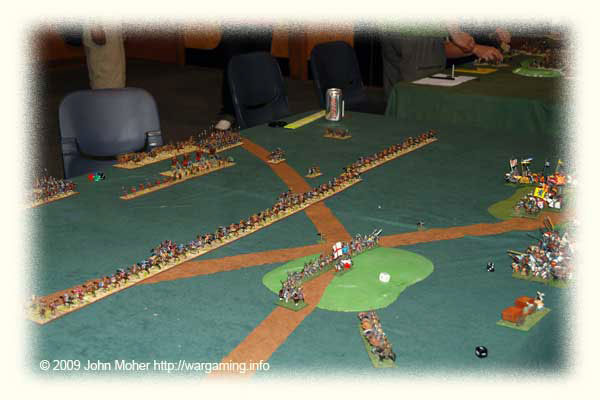
There was an open space on both sides of the Portuguese line, although on my left it was much smaller than the large gap Campbell faced on the right. After our initial advance in line (see above) I aggressively peeled off a detachment of Chionites and sent them racing for the extreme left edge of the table to try and turn the Portuguese line – “On table flank marches are a waste of time and they always go wrong” quipped Campbell, “but its worth a crack” I retorted, ironically we’d both be right, although I think Campbell held the morale high ground in the aftermath of the game!
Meanwhile on Campbell’s right flank not a lot was happening – some of his Chionites were skirmishing with the dismounted English Knights on the central hill, and he was looking to move around their flank, with his Cataphracts starting to move in this direction… At this time the Portuguese then disclosed the aforementioned ambush in the marsh at their extreme left rear which contained 6 elements of Longbowmen and as at that time it didn’t materially affect the game in our opinion and the troops would otherwise have been on table very close to that position anyway we opted just to continue… Anyway on we went, and those Longbowmen did advance fairly aggressively to form up on the open flank of the Portuguese line.
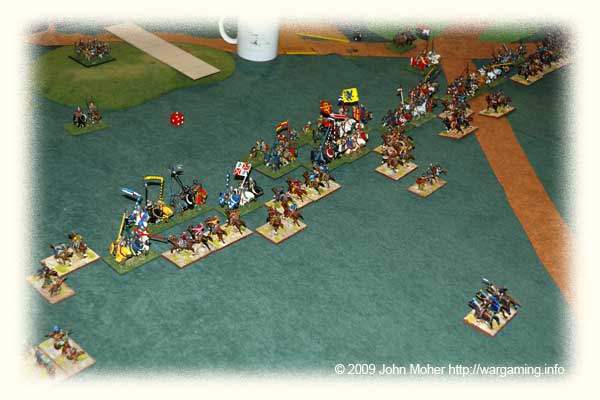
Back on my flank my ‘on-table flank march’ was at the table edge and preparing to turn in towards the end of the Portuguese line, however the Portuguese pulled their Crossbowmen into column and advanced towards the Lh(S) to pin them against the table edge, while their main line of knights suddenly began to lurch forward – and from that point it was all on – my Chionites responded and gamely took on the Knights frontally, having sufficient numbers to turn their flank as well since part of the flank guard (the Crossbowmen) were fighting their own battle with my ‘mini flank march’ of Lh(S). A prolonged melee erupted gradually spreading all along the line from my left flank through towards the centre of the table – Cam brought up the centre command’s Chionites in support, and began pushing the Elephants forward. I would have liked to have brought up my Cataphracts but they were well back and I lacked the PiPs once things had become a real full-on furball! The photo above gives you an idea of the situation after about 3-4 bounds of combat, there is further combat to the left (out of picture) as a couple of my Chionites do battle with the column of Crossbowmen, and on the last page of this report you can see a picture from just before the above one showing the bottom left part in close-up – as a Chionite Lh(S) and Kushan Auxilia are about to eliminate the exposed Portuguese Kn(O) General on the end of the line!
The furball on the left continued in brutal fashion, both sides losing elements regularly, the only difference being the Portuguese were losing them from 2 different commands and the Kushans all from mine! The lines were getting thinner and thinner and (as can be seen above) the opposing flank commands were soon close to demoralisation and finally the impetus faded as each side struggled to get the best last attack to get the 1 or 2 elements needed to break the opposing command – however the action had now rippled down the line and the intensity picked up in the centre. So on Cam’s right flank he was trying to take out the advancing English (foot) Longbowmen, using Cataphracts flanked by Chionites, but it proved costly and 2 Cataphracts were lost, causing Cam to pull back from that attack and concentrate on supporting the central attack and fighting the dismounted English who had now come forward off their hill supported by 4 elements of mounted Longbowmen (see picture below). By this stage the Elephants were coming close to entering the fray, although they were facing the elite of the Portuguese force, the command containing the Kn(S)…
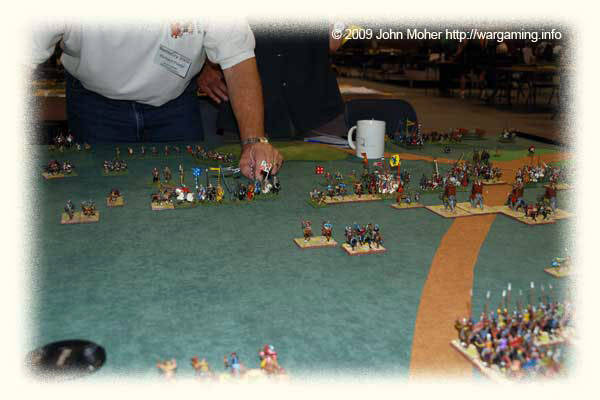
The Chionites were still doing fantastic work against the Knights in general, and on my left if only the Cataphracts had been at hand to exploit (or at least plug gaps) a decisive result might have been achieved for the Kushans – instead both sides ground themselves into the ground. Cam was holding his own in the centre but the right flank command had suffered due to the Cataphract loses against the longbowmen. The loss of a couple of Chionites (and eventually an Elephant) soon had the central C-in-C’s command getting a bit critical too… In the centre however the C-in-C’s Elephants were finally just starting to get into action – with mixed results! While one was lost a couple of critical Knight elements were taken out! And the Portuguese had also burnt up PiPs rushing their remaining foot (who had been in ambush behind the hill on the Kushan left) up behind in support of the Knights, to take on the Elephants as needed…
Ironically when we thought we had had it, and things were getting critical we had a chance to win the game, we had a bound where destroying a Knight at favourable odds (+1 and needing to double if I recall correctly) would put that command within about 0.5 ME of breaking leaving it vulnerable to the risk of breaking if the neighbouring command broke (due to the cascade effect) – in that first bound we failed. We then had 3 bounds following where we fought 2 other combats which if we won both the cascade effect (either way) would break the Portuguese (plus we succeeded in the first of the 3 bounds with the above combat which was a prerequisite) – for 2 of the bounds in one combat we fought at an advantage (evens but an auto kill – i.e. Elephant vs. Knight) just needing to beat the Portuguese Kn(S) – but both times drawing! In the second of these bounds it also became a case of if the Portuguese won that combat it would also break a Kushan Command and the cascade would break the Kushan army (due to other losses elsewhere)! In the second of the three bounds we got the other combat required, setting up the big win, but as mentioned for the second bound in a row we drew the combat, despite the big advantage! By the third bound we had a flank attack from a Knight disadvantaging us, but we could still win the game by beating them by (again if I recall correctly) 2 on the dice! It all came down to this (see photo below, left middle)!
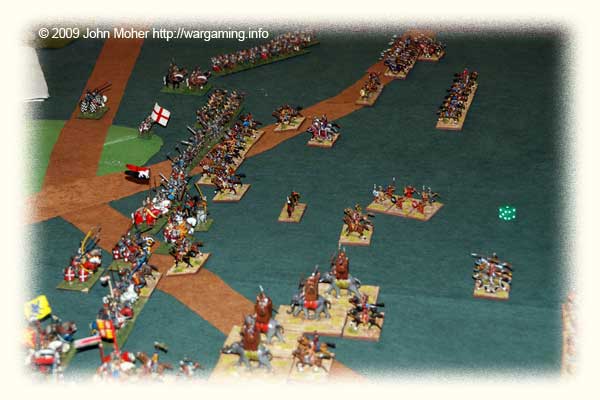
And we lost! Sadly we lost the last critical combat and with the flank contact our Elephant was destroyed by the Knights, and the cascade broke my teetering command on the left as well, the Portuguese army left hanging on by a thread and gaining a fairly decisive victory from the near possibility of defeat (They lost 2 Generals I think plus over 20% of their army – mostly Knights)! The final result was 19-6 to the Portuguese, giving an indication of the level of casualties spread across both armies. The final photo above gives an idea of the barrenness of the battlefield by the final moment – this was one of the more intense and exciting DBMM games I have played, and played in very good spirit, and in hindsight was very enjoyable & challenging. When you consider my flank command’s Kn(X) & General never participated in the battle (see above photo, centre bottom) the left flank’s 10 Chionite LH(S) and a couple of Ax(O) did an awful lot of successful damage against a reasonable number of opposing Kn(O) and Bw(O) from two enemy commands (albeit with a little support from the Chionites in the central command) although ultimately obviously with heavy casualties – I think they really proved their mettle as a surprisingly effective combat force when needed.
One die roll different and the game could well have ended up about a 23-2 victory to us, so it really was a bit of a ‘classic game to remember’ type challenge in many ways. This was the game of the Tournament for me; and I think for both the teams involved in terms of competition results also. The actual result however left us on 31 points, and in 3rd place behind the joint leaders on 33 points (Ivan & Dickie with the Portuguese, and Philip & Andrew with the Kushites), like us Philip & Andrew had fought a brutal close battle before succumbing after their big 25-0 win in the first round, but getting more points than us they held their 1st equal position.
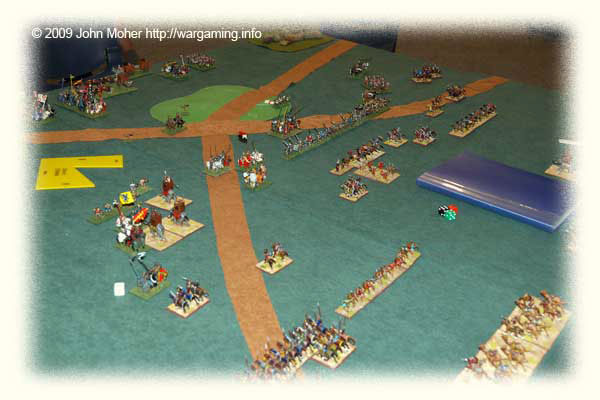
And Campbell had been right in some ways – on table flank marches don’t really work (3 of the 4 elements in this game ending up dead and being a PiP drain), but we had almost won the game and that ‘flank march’ actually did destroy a couple of elements and drew off the supporting Bw(O) from the main Kn(O) battleline, so what if I hadn’t done it – would it have changed the left flank battle significantly…?
One curiosity Campbell observed was that while I had only commanded one command for the day, my command in both battles had done two-thirds of the damage to the enemy, while Cam had commanded 2 commands and one or both had usually not been heavily committed or had only done so later in the battle (once there was potential to decide the result, and usually had done only minor damage to the enemy). Tomorrow would be another day…
Continue to BC’09 Round 3: Later Carthaginians 202BC.
